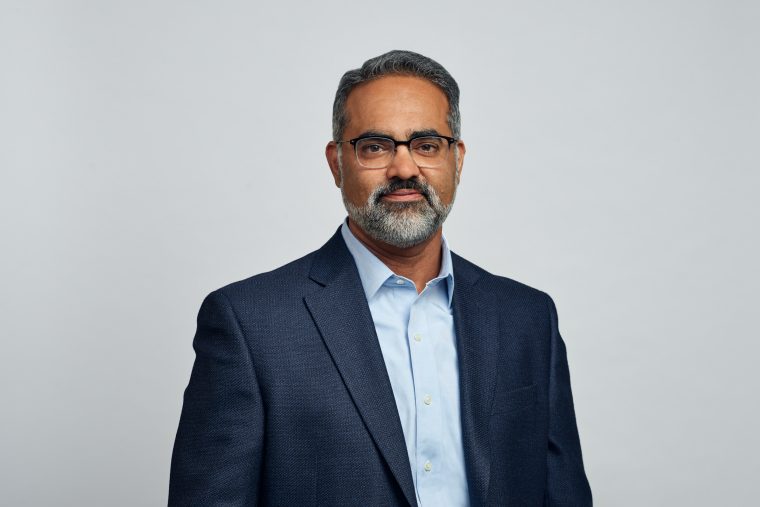Startup Led by Dhanda ’95 Developing COVID-19 Diagnostic Tests


A lack of fast, reliable diagnostic testing has played a major role in the rapid proliferation of cases of COVID-19. Rahul Dhanda ’95 and his team at Sherlock Biosciences are working furiously to change that, potentially shortening the testing’s time horizon to a matter of minutes.
Dhanda is co-founder, CEO, and president of the engineering biology startup based in Cambridge, Mass., which is creating two different diagnostic tests for COVID-19—one rooted in CRISPR technology, the other in synthetic biology. The hope is that the tests can be released during the course of the current pandemic, Dhanda said, each with its own different applications and utility.
A history major who also took premed classes at Wesleyan, Dhanda earned his MBA at the Massachusetts Institute of Technology before forging a successful career in the biotech field, with a specialty in diagnostics.
“One of the nice things about being focused on the sciences, and going to Wesleyan in particular, is that it gives you a great appreciation for the humanities and their role in the sciences,” Dhanda said. “I always had the understanding that there’s a broad, social impact of … new technologies.”
He recently shared his perspective on healthcare interventions, what it’s like to be working on a pressing, global issue like COVID-19, and the impact he hopes Sherlock’s work can have in combatting the crisis.
What are your days like at Sherlock Biosciences right now? You must feel both an incredible responsibility and incredible pressure.
Rahul Dhanda: Once [COVID-19 started to spread], we had to balance a couple of things. We knew we had to keep working, and we also had to protect the team from exposure to anyone who may have had the disease. So, pretty early on we came up with policies so that we could continue to work without increasing that risk. Ahead of Massachusetts’s decree for people to remain at home, we came up with a structure where some people are working from home and some people—those who are driving the tests forward—are working in the office. We’re finding that balance and making good use of things like videoconferencing. We’re making sure that people have contact with each other every day so that everyone feels very connected.
It’s a team that is fully obligated to tackle the challenge, so they’re driven to show up and do the work. In many ways, it’s harder for people who are staying at home to not be there, but they are doing an equally important job by being remote. Certainly, everyone feels the pressure, but they don’t feel that as much as they do the obligation and commitment.
Can you explain how the technology works in Sherlock’s diagnostic tests?
RD: There are a lot of factors in this answer, but at the base there are two different platforms: One is called SHERLOCK (short for Specific High Sensitivity Enzymatic Reporter unLOCKing); the other is INSPECTR (short for INternal Splint-Pairing Expression Cassette Translation Reaction).
The SHERLOCK platform applies CRISPR technology to something other than editing DNA. It’s taking advantage of all of the robustness and precision of CRISPR for gene editing, but applying that to diagnostic uses. With CRISPR, a Cas enzyme is complexed with a guide RNA—a short sequence of RNA—that targets a specific sequence to which it hybridizes. It’s incredibly specific for whatever it’s searching to find. In gene-editing, you find a target that you want to edit, and you cut, copy, and paste in the replacement sequence. With SHERLOCK, instead of cutting the target, the enzyme cuts DNA and RNA surrounding the target, and we use the pieces being cut by labeling them a specific way to generate a signal. That allows us to not only detect the target, but amplify the signal. We can identify SARS CoV-2 (COVID-19) or anything else.
The INSPECTR technology, which is equally exciting, is synthetic biology-based. We use cell-free systems (the biology within a cell that remains intact if you break open a cell). That machinery is used as a diagnostic for whatever target we’re trying to identify, which in this case is SARS-CoV-2. In the test, we have a set of synthetic genes, or cassettes, that are broken into fragments. We can program that gene to do whatever we want, including producing a signaling peptide or protein. If the virus is present, meaning that its RNA is present, the gene cassette will reassemble because parts of it recognize the virus and the pieces line up appropriately when that recognition occurs. Then, the cell-free system activates, and we generate the programmed peptide. If there is no viral target, then there is no peptide or protein.
When it’s fully developed, how would someone use the test?
RD: The way we use it is [to apply it in] something like a pregnancy test, or a simple paper strip. This would be an off-the-shelf system that is specific to this virus or any other organism, including humans and bacteria; we can take it into the home and completely change the way that viruses are measured and spread. This version is behind our SHERLOCK product, but we are accelerating its development given the profound impact it can have. Right now, most of the tests for COVID-19 are taking hours, and we have the ability to bring that answer to less than an hour, and closer to 30 minutes as we make more progress.
Sherlock Biosciences was founded in 2019. Have you been working on COVID-19 all along?
RD: We started [work on COVID-19] when the outbreak occurred. From a company strategy perspective, we were focusing on pandemic respiratory infections as a targeted strategic area. At the time, no one had identified this infection, but when the outbreak occurred, we decided we should shift gears toward that. Both of these tools are rapidly programmable responses to a pandemic or an emerging pandemic, precisely because the pace to develop and design a test even for a very young company like Sherlock is incredibly rapid. We all felt we had to join the fight against this, especially because we have tools that are uniquely suited to address the threat.
Any thoughts on how we can better collectively address COVID-19 right now?
RD: The most important thing is for people to actually abide by the direction that has been given as it relates to social distancing: limiting your exposure to other people, keeping yourself healthy, and informing those around you when you’re not. The people on the front lines need us to do our parts to keep them safe. The most important longer-term lesson here is that there are pandemics that are arising and will arise. What I hope we all learn is we can be better prepared for them by accelerating the things that we were caught off-guard by in this particular case. This is a call to be prepared for the next pandemic.
Are you optimistic about our ability to end this current pandemic?
RD: I am optimistic. If you’re leading a company, whether it’s combating COVID-19 or anything in healthcare, you have to be optimistic about our ability to apply healthcare interventions for improving the world. We have to be optimistic, also, because most of how we address this is through human behavior, and we have to believe that people are going to do the right thing. I’ve seen my entire industry mobilize immediately and with tremendous urgency to combat the crisis. Everyone came to this collaboratively as opposed to competitively. If given the choice and the chance, people who I have encountered are making the right decisions.

